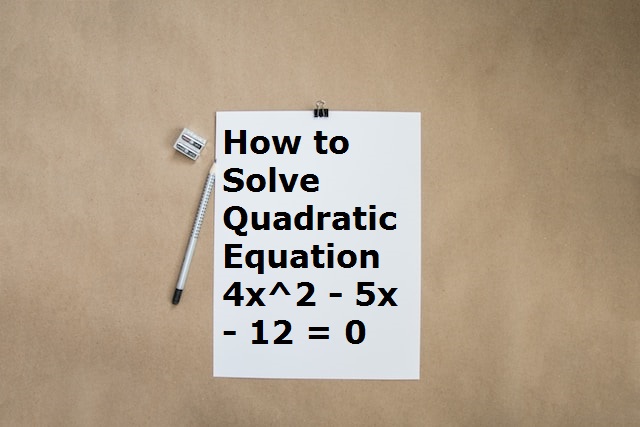The quadratic equation, a fundamental concept in algebra, plays a crucial role in understanding and solving various mathematical problems. One such quadratic equation that often challenges students is 4x^2 - 5x - 12 = 0. In this article, we will unravel the mystery behind this quadratic equation and explore the methods to solve it.
Understanding the Quadratic Equation:
A quadratic equation is generally expressed in the form ax^2 + bx + c = 0, where "a," "b," and "c" are coefficients, and "x" represents the variable. In the case of 4x^2 - 5x - 12 = 0, the coefficients are "4," "-5," and "-12."
Methods of Solving Quadratic Equations:
There are various methods to solve quadratic equations, including factoring, completing the square, and using the quadratic formula. Let's explore each method in the context of our equation.
Factoring:
To factor the quadratic equation 4x^2 - 5x - 12 = 0, we need to find two numbers whose product is equal to the product of the coefficient of x^2 term (4) and the constant term (-12) and whose sum is equal to the coefficient of the x term (-5).
The factors of 4 and -12 that satisfy these conditions are 3 and -4. Therefore, we can express the equation as (4x + 3)(x - 4) = 0.
Setting each factor equal to zero gives two solutions:
4x + 3 = 0 --> 4x = -3 --> x = -3/4
x - 4 = 0 --> x = 4
So, the solutions are x = -3/4 and x = 4.
1. Completing the Square:
Completing the square involves rewriting the quadratic expression as a perfect square trinomial. The process for our equation is a bit involved, but it ultimately leads to the same solutions obtained through factoring.
2. Quadratic Formula:
The quadratic formula is a universal method for solving quadratic equations and is given by:
x = (-b ± √(b^2 – 4ac)) / 2a
Applying this formula to 4x^2 - 5x - 12 = 0, where a = 4, b = -5, and c = -12, we get:
x = (5 ± √(-5)2 – 4(4)(-12)) / 2(4)
Simplifying further yields the solutions x = -3/4 and x = 4.
Conclusion:
Solving the quadratic equation 4x^2 - 5x - 12 = 0 may seem challenging at first, but by employing methods like factoring, completing the square, or using the quadratic formula, we can arrive at the solutions. These techniques not only help us find the roots of the equation but also deepen our understanding of the principles underlying quadratic equations. With practice, the mastery of such equations becomes an essential tool in the mathematical toolkit of students and enthusiasts alike.










